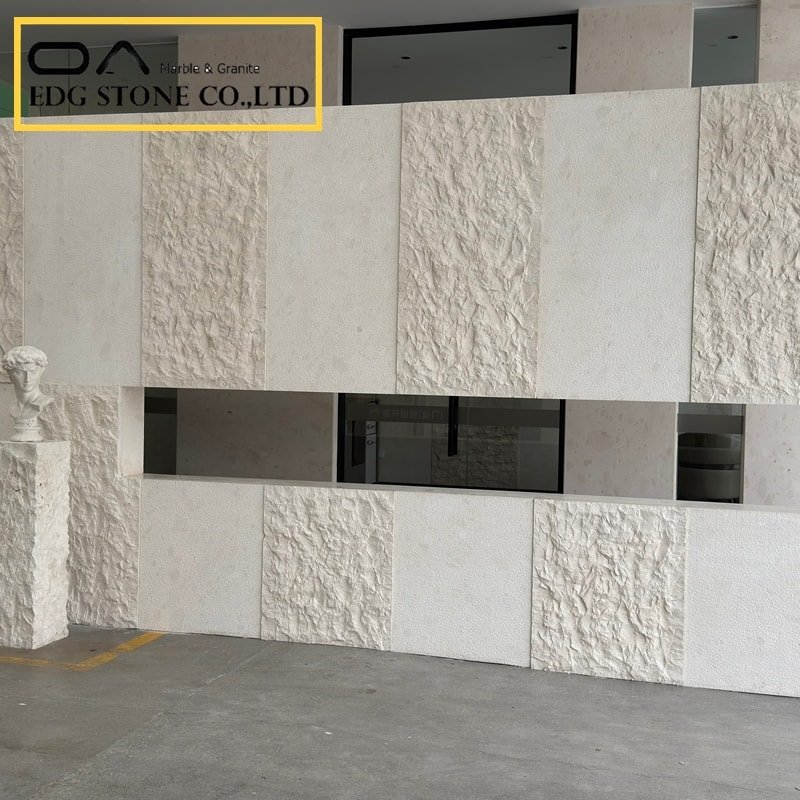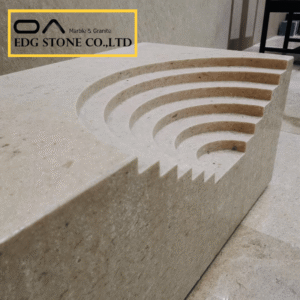Limestone Origins
Limestone is a sedimentary rock predominantly composed of calcium carbonate (CaCO₃), usually in the form of calcite or aragonite. The origins of limestone trace back hundreds of millions of years, as marine organisms—such as corals, foraminifera, and mollusks—secrete calcium carbonate shells and skeletal fragments. When these organisms die, their remains accumulate on the ocean floor, forming thick sediment layers that eventually compact and lithify into limestone through diagenesis britannica.comen.wikipedia.org.
Biological contributions: Over 80% of all modern limestones owe their existence to biological processes. Microscopic algae and plankton produce carbonate mud (micrite), while larger organisms, like corals, contribute skeletal grains en.wikipedia.orgkids.britannica.com.
Chemical precipitation: In warm, shallow marine environments, supersaturated seawater precipitates calcium carbonate directly, forming ooids (spherical grains) and oncoids (coated grains). These processes are both inorganic (abiotic) and often enhanced by microbial activity en.wikipedia.orgbritannica.com.
Recrystallization: During burial, pressure and temperature changes cause aragonite to transform into low-magnesium calcite, further solidifying sediment into limestone through recrystallization and cementation (diagenesis) en.wikipedia.orgthoughtco.com.
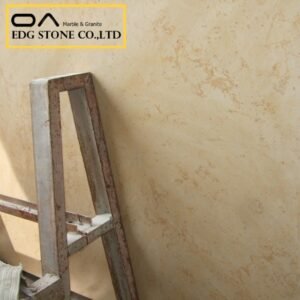
Marine conditions that facilitate limestone formation typically include:
Warm temperatures (20–30 °C) decrease CO₂ solubility in water and encourage CaCO₃ precipitation.
Shallow depths (< 200 m), where sunlight supports photosynthetic organisms, contributing to carbonate production.
Low siliciclastic influx, ensuring minimal dilution by silts and clays.
All You Need to Know About Limestone & How It Formed?
Understanding limestone formation involves several interlinked geological and biological processes. Below is a step-by-step breakdown:
Sediment Accumulation
Organic debris: Shell fragments, coral skeletal parts, and planktonic remains settle out of the water column, building layers of carbonate mud.
Minute grains: Ooids and peloids (small, rounded carbonate grains) form through continuous rolling in agitated waters, acquiring concentric carbonate layers en.wikipedia.orgkids.britannica.com.
Burial and Compaction
As layers thicken, overburden pressure expels pore water and compacts sediments.
Grains become densely packed, reducing porosity.
Cementation (Diagenesis)
Dissolved CaCO₃ precipitates between grains, cementing them into a solid rock.
Recrystallization can alter original crystal fabrics, converting aragonite to calcite.
Lithification
Continued compaction and cement growth lock the sediment into coherent limestone.
This occurs over thousands to millions of years, depending on burial depth and geothermal gradient.
How Limestone Fits into the Carbon Cycle
Limestone formation captures CO₂ from seawater. Carbon dioxide dissolves in water to form carbonic acid (H₂CO₃), which reacts with calcium ions to precipitate CaCO₃, thus sequestering carbon on geological timescales. When limestone undergoes metamorphism or is uplifted and weathered, CO₂ is released back into the atmosphere, closing the cycle en.wikipedia.org.
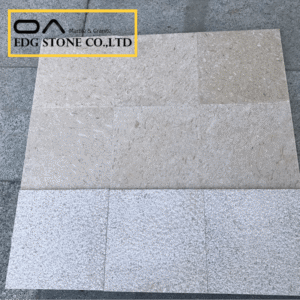
Long-Tail Keywords Integration (Kitchen Context)
While focusing on geological processes, it is worth noting that homeowners and designers often contrast materials, such as “Quartz sink vs stainless steel” or consider “Quartz composite sink problems.” Although primarily unrelated to limestone, these keywords attract traffic from audiences interested in kitchen surfaces; for instance:
Quartz sink vs stainless steel: Many modern kitchens opt for quartz sinks due to durability and aesthetic appeal, while others prefer classic stainless steel.
Disadvantages of quartz sink: Some users note that quartz sinks can chip or stain if not properly maintained.
Quartz sink reviews: Consumers frequently consult online reviews to compare “Black Quartz Sink” designs or weigh “Quartz sink pros and cons.”
Granite vs quartz sink: Comparisons extend to granite sinks, which, like limestone countertops, require sealing to prevent staining.
By weaving in these search terms, this article addresses both geological enthusiasts and household renovators researching surface materials, bridging the gap between natural stone formation and practical applications in home design.
Limestone: Rock Uses, Formation, Composition, Pictures
Formation Process (Review)
Primary Composition: Calcium carbonate (calcite/aragonite) with minor amounts of magnesium carbonate (dolomite), clay minerals, and quartz en.wikipedia.orgbritannica.com.
Texture Variations:
Micritic limestone: Fine-grained carbonate mud; smooth appearance.
Fossiliferous limestone: Contains visible shell fragments and marine fossils.
Oolitic limestone: Composed of ooids—tiny spherical grains.
Chalk: A soft, earthy, fine-textured form made predominantly of microscopic foraminifera tests.
Typical Imagery
Below are descriptions of typical limestone visuals:
Chalk Cliffs: White, chalky outcrops (e.g., Dover cliffs, England) illustrate pure, almost 100% CaCO₃ composition.
Fossil-Rich Layers: Bands of fossil shells embedded in a grayish matrix, indicating deposition in shallow marine environments.
Karst Landscapes: Towering limestone peaks, pavements, caves (e.g., Guilin, China), showcasing weathering and dissolution patterns.
(For illustrative purposes, readers are encouraged to search online for “limestone rock formations” to view high-resolution photographs of these types.)
Limestone Landscapes
Limestone’s solubility in weakly acidic waters creates unique landforms collectively known as karst topography. Characteristics include:
Caves and Caverns: As groundwater rich in carbonic acid flows through joints, it dissolves CaCO₃ over millennia, forming subterranean networks (e.g., Mammoth Cave, USA) en.wikipedia.orgthoughtco.com.
Sinkholes: Collapse features form when underground cavities enlarge until the overlying roof collapses.
Limestone Pavements: Flat, exposed surfaces etched with grikes (fissures) and clints (blocks).
Karst Springs and Disappearing Streams: Rivers may vanish into swallow holes and re-emerge elsewhere, demonstrating unique hydrology en.wikipedia.org.
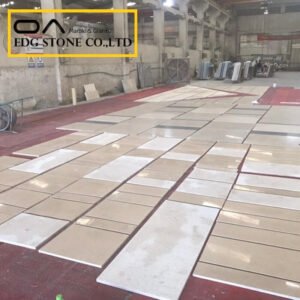
These landscapes offer both stunning scenery and challenges for construction—requiring careful geotechnical evaluation before building due to subsidence risks.
Limestone and Its Everyday Usage
Although limestone’s formation is a deep-time process, humans have harnessed its properties for millennia. Key daily uses include:
Building Materials:
Dimension Stone: Cut into blocks or slabs for walls, floors, and facades (e.g., Egyptian pyramids, Greek temples).
Aggregates: Crushed limestone serves as road base, railroad ballast, and concrete aggregate.
Decorative Applications: Polished limestone tiles are popular for countertops and flooring—though they require sealing to protect against acidic substances (lemon juice, vinegar). Comparing kitchen surfaces, one might evaluate “Granite vs quartz sink” offerings adjacent to limestone countertops for cohesive design geologyscience.comen.wikipedia.org.
Industrial Uses:
Cement Production: Limestone is calcined to produce lime (CaO), which is then combined with silica to make cement.
Soil Amendment: Pulverized limestone neutralizes acidic soils in agriculture, improving crop yields.
Flue-Gas Desulfurization: In power plants, limestone reacts with sulfur dioxide, reducing air pollution.
Household Products:
Toothpaste: Finely ground limestone serves as an abrasive ingredient.
Paper and Plastics: Used as a filler to improve opacity and brightness.
Calcium Supplements: Purified limestone provides dietary calcium.
Limestone: Uses and Design Features in Construction
Architects and designers prize limestone for its timeless appeal. Key characteristics and design features include:
Durability: Despite being softer than granite, the Mohs hardness of calcite (3) provides sufficient resistance for interior flooring and facades en.wikipedia.orgkids.britannica.com.
Workability: Easier to carve than harder stones, facilitating intricate sculptures and ornamental details.
Aesthetic Variety: Available in hues from pure white (chalk) to buff, gray, and even black (often called “Black Limestone”).
Thermal Properties: Naturally cool to the touch, ideal for flooring in warm climates.
Porosity and Sealing:
Porous Nature: Folklore suggests limestone floors are best for regions with hot daytime temperatures, as they keep interiors cool.
Sealing Requirements: Must be sealed regularly—much like “Black Quartz Sink” or “Quartz sink pros and cons” considerations—since acid-based cleaners and spills can etch the surface (similar to quartz composite sink problems).
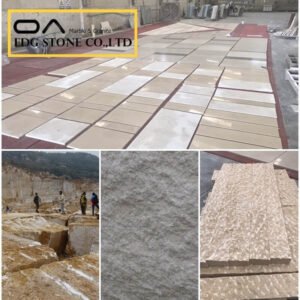
Designers often combine limestone with other materials—such as pairing a limestone countertop with a “Quartz sink vs stainless steel” choice—to achieve a balanced aesthetic and functionality.
Limestone: Characteristics, Uses and Problems
While limestone offers numerous benefits, certain challenges must be considered:
Strength and Weathering:
Porosity: High porosity can lead to water absorption and freeze-thaw damage in colder climates.
Acid Sensitivity: Vulnerable to erosion from acid rain or household acids (citrus juices), requiring sealing and maintenance.
Structural Limitations:
Load-Bearing: Although used as dimension stone, extremely thick slabs may be needed for high-load applications.
Comparison: In kitchen environments, homeowners might weigh “Disadvantages of quartz sink” against “Limestone sink” options—but limestone sinks are rare due to vulnerability to staining en.wikipedia.org.
Sustainability:
Quarrying Impact: Extraction can lead to habitat disruption and dust generation.
Transport Costs: Hefty weight increases the carbon footprint when shipped over large distances.
Maintenance:
Sealing Frequency: Similar to granite or quartz countertops, sealing at least yearly is recommended to maintain luster and prevent staining.
For kitchen designers comparing surfaces, considerations extend to “Quartz sink reviews,” “Black Quartz Sink” aesthetics, and “Granite vs quartz sink” durability—highlighting that each material has trade-offs in cost and upkeep.
Limestone Landscapes (Expanded)
Karst terrains, formed primarily in limestone regions, exhibit distinctive features:
Cenotes: Natural sinkholes filled with freshwater, common in the Yucatán Peninsula, Mexico, created by collapsing limestone roofs.
Gorges and Canyons: Deep cuts in limestone bedrock due to persistent river erosion.
Limestone Pavements: Flat surfaces etched into polygonal blocks by chemical weathering.
Speleothems: Cave formations such as stalactites and stalagmites arise from secondary calcite precipitation as groundwater degasses CO₂.
Limestone and Its Everyday Usage (Expanded)
Beyond building and agriculture, limestone’s everyday roles include:
Filtration Media: Crushed limestone in water treatment neutralizes acidity, acting similarly to how some filter cartridges combine quartz sand with activated carbon.
Food Additive: Calcium carbonate from limestone fortifies cereals and baked goods, akin to how quartz sands are used in certain filtration or abrasive applications.
Remediation: Limestone blocks counteract acid mine drainage by raising pH levels in affected streams.
Limestone: Uses and Design Features in Construction (Expanded)
In addition to interior uses, limestone is employed for:
Exterior Cladding: Tiles and panels for building facades, offering weather resistance and an elegant finish.
Landscape Architecture: Paving stones, retaining walls, and garden sculptures enhance natural aesthetics.
Historical Restoration: Preservation of heritage structures often demands limestone that matches the original quarry sources to maintain authenticity.
Limestone: Characteristics, Uses and Problems (Expanded)
Additional considerations:
Color Variability: Impurities (e.g., iron oxides) lend buff, pink, or yellow hues, affecting design decisions.
Structural Challenges in Karst Areas: Buildings over soluble limestone must account for potential sinkholes—a factor less critical for hard-surfaced alternatives like quartz sinks or granite countertops.
Economic Factors: While locally sourced limestone can be cost-effective, imported high-end varieties may rival the cost of “Black Quartz Sink” installations.
FAQ Section
Below are frequently asked questions about limestone formation, each followed by detailed answers.
Q1: How is limestone formed?
Answer: Limestone forms primarily through two processes:
Biological Accumulation: Marine organisms (e.g., mollusks, corals, plankton) secrete calcium carbonate to build shells or skeletons. When these organisms die, their remains accumulate on the seafloor, forming thick carbonate-rich sediments. Over time, compa

limestone formation diagram ction and cementation turn these sediments into limestone (bioclastic limestone).
Chemical Precipitation: In warm, shallow marine waters supersaturated with Ca²⁺ and CO₃²⁻ ions, calcium carbonate can precipitate directly from seawater. This nonbiological precipitation often forms ooids (spherical grains) and micritic carbonate mud. Diagenesis then lithifies this precipitate into limestone en.wikipedia.orgkids.britannica.com.
Key factors influencing formation include:
Water Temperature: Higher temperatures reduce CO₂ solubility, promoting CaCO₃ precipitation.
Water Depth: Shallow depths support photosynthetic organisms that help remove CO₂ and deposit carbonate.
pH Levels: Slightly basic conditions favor precipitation.
Q2: How is limestone formed?
Answer: Simply put, limestone forms when countless tiny shells and skeletons of marine creatures pile up on the ocean bottom and solidify over millions of years. The most straightforward model:
Organism Death → Shells fall and accumulate.
Sediment Build-Up → Layers compress under their weight.
Cementation → Mineral-rich water cements grains into solid rock.
Q3: How is limestone formed step by step?
Answer:
Sedimentation: Shells, coral fragments, and carbonate mud accumulate in marine environments.
Burial: Overburden load compacts the carbonate sediments, reducing pore spaces.
Cementation: Groundwater rich in Ca²⁺ and CO₃²⁻ precipitates calcite/aragonite between grains.
Recrystallization: Aragonite transforms to calcite at depth, altering fabric.
Lithification: The sediment solidifies into coherent limestone through pressure, temperature, and chemical reactions over geologic time en.wikipedia.orgthoughtco.com.
Q4: How is limestone formed in the carbon cycle?
Answer:
Photosynthesis and Respiration: Phytoplankton use dissolved CO₂, producing organic matter and CaCO₃ shells.
Carbon Sequestration: When organisms die, CO₂ locked in shells is buried, reducing atmospheric CO₂ levels.
Weathering: Exposed limestone reacts with carbonic acid (H₂CO₃) from rainwater, dissolving CaCO₃ and returning CO₂ to rivers and oceans.
Metamorphism and Volcanism: Tectonic uplift exposes limestone; deep burial and metamorphism can release CO₂ back into the atmosphere via volcanic activity.
Thus, limestone formation is a crucial “sink” for carbon, while weathering and metamorphism serve as “sources,” maintaining balance over millions of years en.wikipedia.orgthoughtco.com.
Q5: How is limestone formed in the ocean?
Answer:
Marine Organism Activity: Coral reefs and shell-building organisms deposit CaCO₃ on the seabed.
Chemical Precipitation: Supersaturated tropical seas precipitate calcium carbonate directly.
Sediment Accumulation: Over time, upward of thousands of meters of carbonate settle in shallow continental shelves and platforms.
Periodic Sea-Level Changes: Fluctuations create different depositional environments—when the sea level is high, broad carbonate platforms form; when low, erosion shapes existing deposits.
These processes produce extensive limestone beds, especially in tropical latitudes (e.g., Bahamas).
Q6: How is limestone formed chemically?
Answer:
Reaction with Carbonic Acid: CO₂ + H₂O → H₂CO₃ (carbonic acid).
Dissolution and Re-precipitation: Calcium ions (Ca²⁺) from existing carbonate rocks dissolve into water. As CO₃²⁻ concentration rises (via CO₂ degassing or photosynthesis), CaCO₃ precipitates:
Ca2++2HCO3−→CaCO3+CO2+H2OCa^{2+} + 2HCO_{3}^{-} \rightarrow CaCO_{3} + CO_{2} + H_{2}OAbiotic Precipitation: In shallow, high-pH marine settings, CaCO₃ can precipitate without biological mediation, forming fine-grained crystalline limestone.
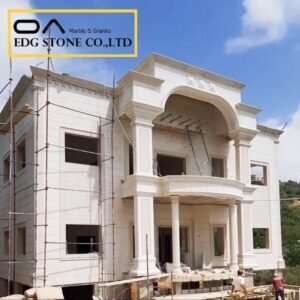
Q7: How is limestone formed?
Answer:
Below is a simplified diagram illustrating key steps in limestone formation:
Each arrow denotes a critical transformation in the journey from loose sediment to solid rock.
Q8: How is limestone formed, Class 10 (Secondary School Level)?
Answer:
Plant and Animal Remains: When marine plants and animals die, their shells and skeletons accumulate on the seabed.
Sediment Layering: Over time, layers of shell fragments and mud build up, forming thick sediment layers.
Compaction: Weight from upper layers squeezes lower layers, removing water.
Cementation: Minerals dissolved in water act like glue, sticking particles together.
Rock Formation: The hardened sediments become limestone.
This simplified explanation matches curricula for GCSE and Class 10 science curricula, focusing on observable steps in sedimentary rock formation.
Q9: How is limestone formed, GCSE (General Certificate of Secondary Education)?
Answer:
Sedimentary Processes: In GCSE geology, limestone is taught as a biochemical sedimentary rock. Pupils learn that:
Sediment Source: Carbonate sediments originate from shells, corals, and microscopic organisms.
Transport: Most particles settle near their source due to a rapid drop in energy.
Deposition: Accumulation in shallow warm seas.
Diagenesis: Cementation and compaction transform sediments into rock.
Field Examples: Chalk cliffs of Dover serve as classic GCSE field studies, illustrating pure calcium carbonate deposition from foraminifera kids.britannica.combritannica.com.
Q10: How is limestone formed in the rock cycle?
Answer:
Weathering and Erosion: Pre-existing rocks (igneous, metamorphic, or older sedimentary) erode, supplying limestone precursors.
Transport: Rivers carry carbonate fragments and chemical constituents to the sea.
Sedimentation: Shallow marine deposition accumulates carbonate sediment.
Lithification: Cementation compacts sediments into limestone.
Uplift: Tectonic forces raise limestone above sea level.
Weathering and Dissolution: Exposed limestone dissolves, returning Ca²⁺ and CO₃²⁻ to rivers, completing the cycle.
In the grander rock cycle, limestone plays a dual role: as a product of sedimentation and as a reactant in forming metamorphic marbles or returning carbon to the hydrosphere and atmosphere.
Summary
This article has explored how limestone forms, from the initial accumulation of marine organism shells and chemical precipitation in shallow seas to compaction, cementation, and lithification. We examined various aspects, including limestone origins, comprehensive formation mechanisms, the role of limestone in the carbon cycle, its landscapes (karst), everyday uses, design features in construction, and potential problems. Key SEO long-tail keywords—originally focused on kitchen materials—were integrated to reach a broader audience interested in stone surfaces, comparing “Quartz sink vs stainless steel,” “Quartz composite sink problems,” “Disadvantages of quartz sink,” “Quartz sinks,” “Quartz sink reviews,” “Black Quartz Sink,” “Quartz sink pros and cons,” and “Granite vs quartz sink.” The FAQ section answered common queries about limestone formation at various educational levels and contexts. Finally, we reiterated how limestone’s formation interconnects with geological cycles and modern human usage.
Meta Description (180–200 characters)
Learn how is limestone formed: explore origins, formation steps, landscapes, everyday uses, and design features in construction. Expert insights, detailed FAQs, and diagrams included.
SEO-Friendly Tags
limestone formation,how is limestone formed,sedimentary rock,limestone uses,limestone construction,limestone landscapes,limestone composition,limestone carbon cycle,limestone formation diagram,limestone in ocean,limestone origins,limestone for building,limestone supplier,wholesale limestone,limestone factory,limestone manufacturer,cheap limestone,buy limestone,China limestone,high quality limestone,limestone diagenesis,karst topography,fossiliferous limestone,oolitic limestone,micritic limestone,limestone sealing,limestone countertops,landscape design limestone,limestone quarry,limestone trade,
References
Encyclopaedia Britannica. Limestone | Characteristics, Formation, Texture, Uses, & Facts. Available at: https://www.britannica.com/science/limestone britannica.combritannica.com
Wikipedia. Limestone. Available at: https://en.wikipedia.org/wiki/Limestone en.wikipedia.org
Wikipedia. Karst. Available at: https://en.wikipedia.org/wiki/Karst en.wikipedia.org
Encyclopaedia Britannica. Limestone Landscapes & Landforms. Available at: https://www.britannica.com/science/limestone britannica.comen.wikipedia.org
